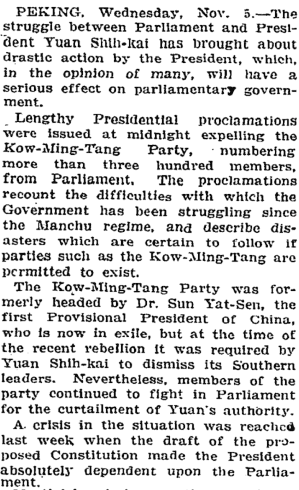A strong Chinese leader takes a bold stance against constitutionalism and Western-style democratic institutions and the foreign community…high fives him for it?
Such was the reaction on November 4, 1913, when Yuan Shikai, President of the Republic of China, expelled more than 300 members with ties to the Kuomintang Party (KMT) of Sun Yat-sen from parliament. Within a few months, and with parliament well short of a quorum, Yuan would abolish the legislative body taking his first steps toward dismantling the Republic and declaring himself emperor.
That’s right. Yuan Shikai, Sith Lord.
The crisis between Yuan Shikai and the KMT began in the spring of 1913 with the assassination of KMT political strategist, and would-be leader of parliament, Song Jiaoren. While there was no proof it is generally assumed that Yuan ordered the hit.
Yuan further drew the ire of parliament by trading concessions to the foreign powers in exchange for loans to prop up his new government.
In response, seven provinces in Southern China rebelled against the government in July 1913, starting the short-lived “Second Revolution.” Forces loyal to Yuan retook control of the renegade provincial capitals by the autumn and Sun Yat-sen was forced to flee to Japan for his own safety.
In October, Yuan and his cronies decided to stop messing around and ordered parliament to formally grant Yuan Shikai full powers as President of the Republic of China.
Paid thugs clogged the streets around the Parliament Building*, intimidating delegates and shouting “If you do not elect the president we want, do NOT expect to leave.”** Even then, it still took two rounds of balloting for Yuan to get his votes and the constitution parliament approved doing the same session gave many of the powers Yuan wanted to the cabinet instead.
Yuan was pissed. Parliament stood firm. And so on November 4, 1913, Yuan revoked the credentials of 357 KMT members of Parliament and declared martial law in Beijing.
On November 5, 1913, the New York Times reported:
Of course, Yuan Shikai, being a Sith Lord and everything, he wasn’t going to stop there:
And if you no longer have the Nationalist Party to help out, why not go really old school?
What did the foreign powers stationed in Beijing have to say about this outrageous affront to a nascent democracy? Well, according to the New York Times, many had a positive view of the development.
The NYT 1913 sources sound a lot like certain academics writing about China today.
In November 1915, Yuan Shikai continued his plan for “strong action” by launching an ill-fated bid to become emperor. His monarchical dreams crashed and burned a few weeks later and Yuan died in 1916.
It’s hard to think that Yuan was the man to save China, and because of his meddling the Republic of China 1.0 never really had much of a chance. Unfortunately, the result was that from 1916 to 1927 (at least) China was, by any definition, a failed state and disorder ran rampant.
----------
* Beijing-based readers might be interested to learn the parliament building survives to this day. It's located just north of the Xuanwumen Subway stop as part of the Xinhua News Service compound. It's now an auditorium building for Xinhua.
** From Immanuel C.Y. Hsü, The Rise of Modern China, Sixth Edition. New York: Oxford University Press, 2008





